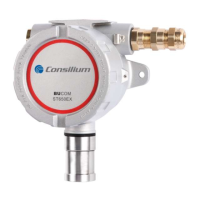ST650EX / ST650-CO
2
/ ST350EX
v3.16
3
IMPORTANT NOTES:
- Read and understand this user manual and all other safety instructions before using this equipment.
- This equipment must be operated by trained and experienced personal only.
- If the ST650EX / ST650-CO
2
/ ST350EX is used in a hazardous environment, the relevant regulations for
explosion hazardous equipment must be observed at all times.
- The gas detector should be installed in an area that is free from shocks or vibrations.
- The gas detector should be accessible for maintenance and/or calibration purposes at all time.
- The gas detector (sinter) should be pointed downwards to avoid accumulation of moisture, dirt, dust and/or
chemical residue. It is also allowed for indoor applications to point the sensor horizontal as long as the
sensor is not affected by moisture, dirt, dust and/or chemical residue.
- IP ratings do not imply that the equipment will detect gas during and after exposure to those conditions.
- During installation the gas detector should be isolated from local earth or conductive surface. The gas
detector should only be connected to a clean earth through cable gland and the shielding of the signal
cable.
- Avoid signal cables close to high power cables, inverters, radio transmission lines, computer
communication cables or cables carrying pulses of high current.
- The ST650EX is designed for the detection (temporarily) of unexpected gas concentrations. The
ST650EX measures various Hydrocarbons. Other gases than the target gas (for example 0-100% LEL
Methane or 0-100% LEL Propane) gives a deviant reading.
- The ST650EX equipped with a catalytic bead sensor is not suitable for use in environments where
continuous concentrations of gas are present. Continues concentrations of gas affects the life time of the
sensor and creates a significant loss of sensitivity.
- A gas detector provided with a catalytic bead sensor is not suitable in areas where silicon compounds,
organometallic compounds, organic phosphate esters, halogen-containing hydrocarbons and sulphur
compounds are present. These environmental factors may significantly reduce the life of the sensor.
- Gas detectors with a catalytic bead gas sensor requires > 10% Oxygen for a correct sensor reading.
- To minimize deviations, circumstances during calibration should approach normal operational
environment (temperature, humidity and pressure).
- Never change a sensor in a potentially hazardous atmosphere while the transmitter is still powered. Keep
cover tight when circuits alive.
- When a combustible gas sensor exceeds the maximum range, the gas detector should be re-calibrated.
- Readings between -3 and +3 are shown as [0] (4mA), readings < -3 are shown as [-0] (2,4…3,52mA),
readings <-10% f.s. are shown as SF (output fixed 2,4mA), out of range is shown as [100] (blinking) and
output is fixed 22mA (will stay at 22mA until unit is recalibrated).
- The time of response of the entire system is determined by the time of response of all parts of
equipment within the gas detection system.
- The EU type examination certificate (EN 60079-29-1) only applies to Methane and Propane for Catalytic
Bead sensors and NDIR sensors in range of 100% LEL.
- IEC60079-20-1 can be used for converting test and calibration gas concentrations from % LEL to
% volume fraction.
- For calibration and maintenance; we recommend to read the procedures described in IEC 60079-29-2
for reference.

